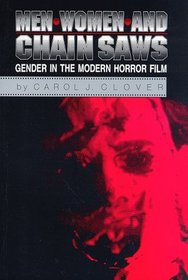I just finished this book which takes a look at how gender is identified, viewed, and presented within horror films. As the book was published in 1992, the analysis is heavily rooted in films from the 70s and 80s and has some problematic points about trans identities. There is also an incredible amount of Freudian theory consulted, and DON'T GET ME STARTED. But, that aside, I really enjoyed the analysis.
The most white bread, basic analysis of the horror genre equates sex and violence or sex and death. We, the viewer, see an often scantily clad, beautiful woman, lust after her, and then without warning see violence done to her person. The idea being that the sudden shift from lust to violence and gore creates a deep uneasiness in oneself, and can oftentimes blur the line between the two.
This book dives deeper into the views and meanings of both genders in horror film, focusing mostly on how a male audience identifies with the characters on screen. More often than not, a male audience is identifying with the female victim on screen, not the (usually) male killer, which queers his gender identity for the duration of the film. This leads into the idea of "female masochism" which is NOT the masochistic tendency of women, but the desire by men to identify with the sadistic tortures being portrayed on the body of the female characters. Over and over again, male audiences return to revel in how it must feel to have a female body and be violated in all kinds of ways. In some films, the male characters become "feminized" by having their bodies torn to have holes or gashes (see: Videodrome) therefore literally becoming a female before our very eyes.
There is also a large discussion about the femininity and sexual repression of male killers - often having mommy issues or having sexual and/or physical abuse in their past, resulting in a very androdgynized persona that ends up either being oversexualized (Peeping Tom) or devoid of sexuality completely.
I would have loved to see an alternate discussion of how female horror film audiences can and do identify with male killers, therefore flipping the script on their gender identity as well, but alas this book ends up being very male gaze-centric.
The takeaway is something that us gay horror nerds have always known: HORROR IS GAY
The most white bread, basic analysis of the horror genre equates sex and violence or sex and death. We, the viewer, see an often scantily clad, beautiful woman, lust after her, and then without warning see violence done to her person. The idea being that the sudden shift from lust to violence and gore creates a deep uneasiness in oneself, and can oftentimes blur the line between the two.
This book dives deeper into the views and meanings of both genders in horror film, focusing mostly on how a male audience identifies with the characters on screen. More often than not, a male audience is identifying with the female victim on screen, not the (usually) male killer, which queers his gender identity for the duration of the film. This leads into the idea of "female masochism" which is NOT the masochistic tendency of women, but the desire by men to identify with the sadistic tortures being portrayed on the body of the female characters. Over and over again, male audiences return to revel in how it must feel to have a female body and be violated in all kinds of ways. In some films, the male characters become "feminized" by having their bodies torn to have holes or gashes (see: Videodrome) therefore literally becoming a female before our very eyes.
There is also a large discussion about the femininity and sexual repression of male killers - often having mommy issues or having sexual and/or physical abuse in their past, resulting in a very androdgynized persona that ends up either being oversexualized (Peeping Tom) or devoid of sexuality completely.
I would have loved to see an alternate discussion of how female horror film audiences can and do identify with male killers, therefore flipping the script on their gender identity as well, but alas this book ends up being very male gaze-centric.
The takeaway is something that us gay horror nerds have always known: HORROR IS GAY




